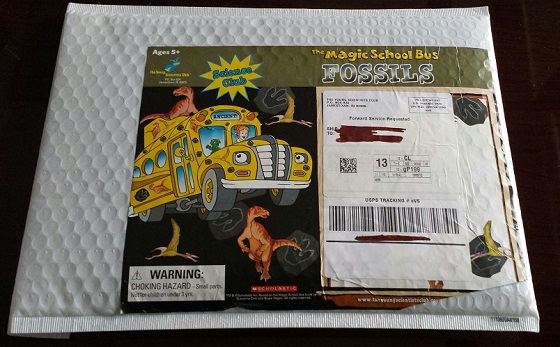
Magic School Bus Science Club is a subscription box for kids that is based on the books and television show "The Magic School Bus" and teaches children about science topics through hands-on activities. The subscription is part of The Young Scientists Club and was developed by a team of Harvard graduates, scientists, and educators!
My Subscription Addiction pays for this subscription. (Check out the review process post to learn more about how we review boxes).

The Subscription Box: Magic School Bus Science Club
The Cost: Regular monthly subscription is $19.99
Ships To: US only (free)
The Products: Every month, Magic School Bus Science Club sends an activity booklet with seven "experiments" and most of the materials to complete them. Each month is built around a science topic.
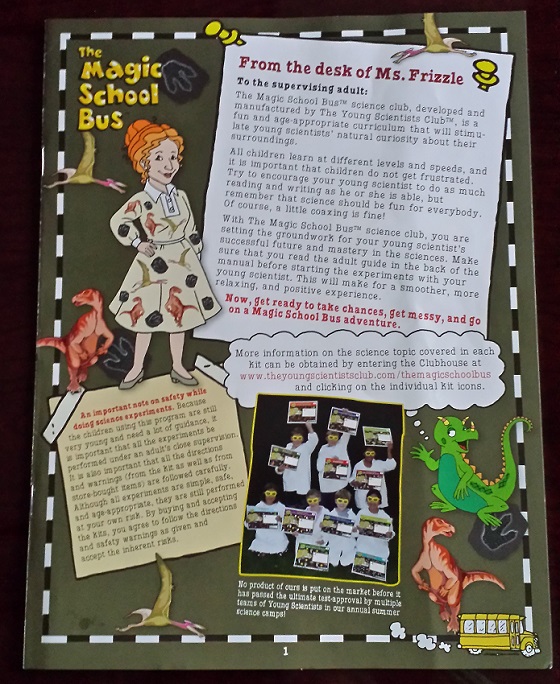
This month's topic is fossils! This is the activity booklet. In the back few pages are notes for parents along with an answer key. This has been a lifesaver for me a couple of times, and this month was one of them! Fossils are cool, but I have a pretty limited expertise when it comes to paleontology. It is true, however, that all little boys (and many little girls) are completely obsessed with dinosaurs, and mine are no exception, so this was an exciting topic for us!
For the purposes of this review, I will only highlight a few of the experiments - enough that you get a good idea of what this subscription is all about. Magic School Bus Science Club is appropriate for ages 5-12 (per their website), and I go through these activities with my eight-year-old son.

This is the booklet page and materials required for Experiment 1. We had to provide our own scissors and tape. There is a piece of white lightweight card stock with seven events that are steps in the formation of a fossil. There are also seven pictures. The goal is to cut out these shapes and then put the events in order, match them to the correct picture, and tape them onto the black construction paper.
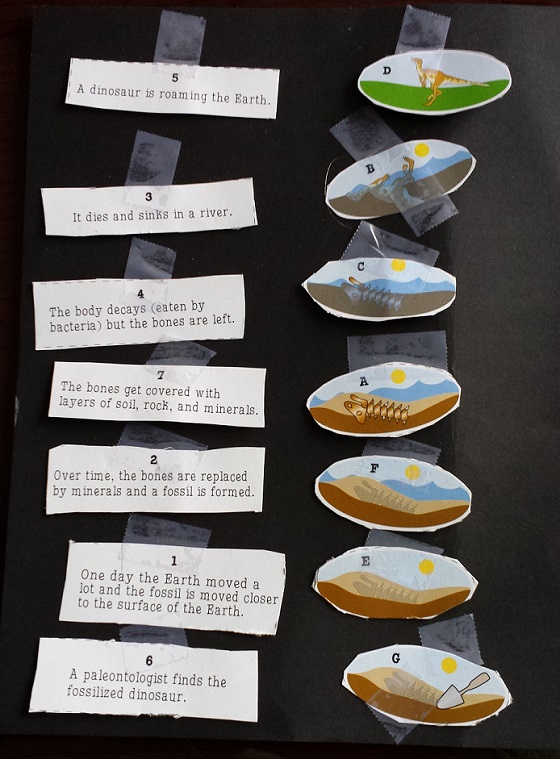
Success! This is where the answer key came in handy. I let my son match them up as best he could, and he came pretty close to getting it all right. We went to the answer key and corrected everything before taping it down to the paper, and we talked about the steps and why they occur in that order. The pictures were fairly easy to match up.
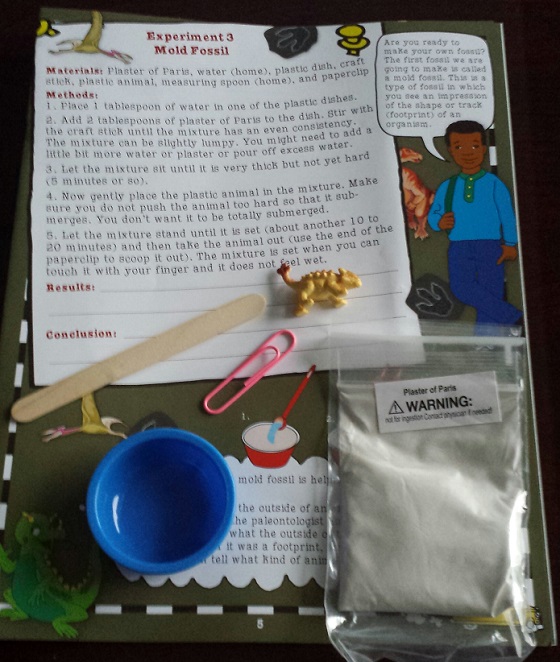
This is the booklet page and materials required for Experiment 3. In this activity, we will be making a plaster mold of a little plastic toy dinosaur!
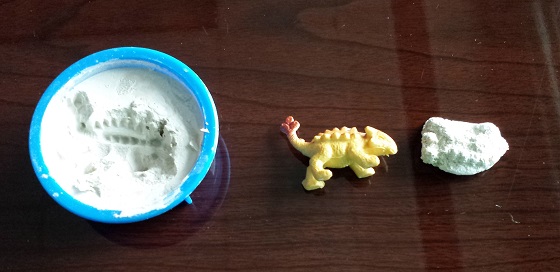
This picture shows the result of this experiment (left), the dinosaur making all these fossils (middle), and on the right is actually the result of Experiment 4. I thought I would include it because it was simply the reverse process, making a cast fossil. For Experiment 3, we mixed up a tiny amount of plaster of paris with a little water in the blue dish, which is about the size of a silver dollar in circumference. We let that set up a little, then we pressed the dinosaur into it and let it set completely. The hardest part of this experiment was getting the dinosaur back out! They included a paper clip to pry him out, but the paper clip wasn't working and it was destroying the fossil! I wound up having to pull him out by one leg!
In Experiment 4, we put some sand into an identical blue dish and moistened it. Then we pressed the dinosaur into the sand to make an imprint. Last, we poured some plaster of paris into the imprint and let it set. The picture on the right shows the result of that. It turned out okay, but not very detailed. I guess that's fine since most fossils are pretty broken up anyway.
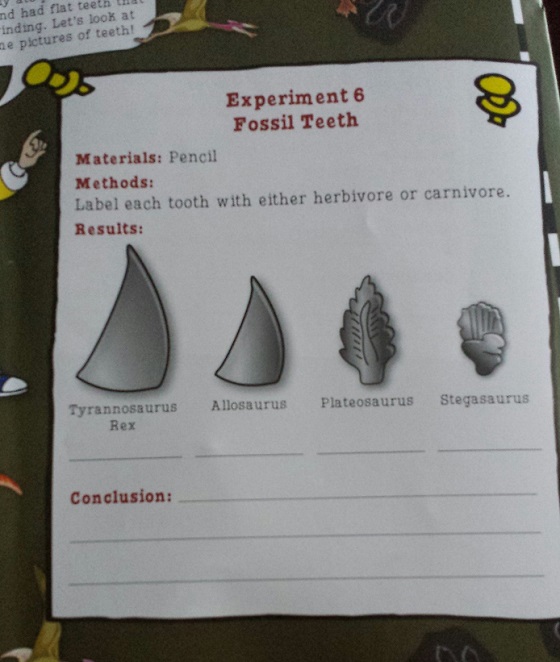
Experiment 6 is simply a worksheet that does not require additional materials. The object here is to look at the pictures of dinosaur teeth and say whether the creature was a carnivore or an herbivore.
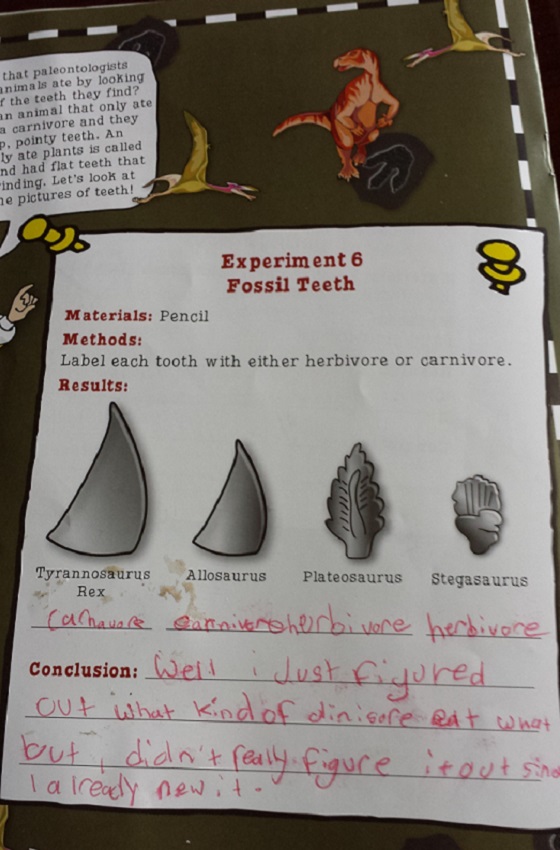
My son totally nailed the activity, but definitely needs work on his spelling and grammar!
Verdict: To be honest, I have pretty mixed feelings about Magic School Bus Science Club. For my eight-year-old, it was fun and a good learning experience, and the activities are all age appropriate. I absolutely cannot see a five-year-old being able to successfully complete the molding and casting experiments, whereas I think a 12-year-old might be insulted by the ease of Experiment 6. I think ages 7-9 or maybe 10 would be a better age range. I also wish that they included more or better materials. Experiment 5 was essentially to paint the fossils using paint from home. I understand that this is an educational subscription and not a craft subscription, but Kiwi Crate often includes paints and brushes with their crafts for the same price. It also doesn't say whether we should use acrylic paints or watercolors or ? Also, not to be too critical, but I don't like that they call the activities "experiments." Maybe it's a little science-nerdy of me, but an experiment should have a hypothesis against which the activity tests. It makes writing a "Conclusion" (which they expect at the end of every experiment) difficult. What should my son write as his conclusion for Experiment 5, paint your fossils? Painting things is fun? Painted fossils make the features easier to see? Painting fossils obscures some features? I have no idea. (Thanks for indulging my science-nerd rant). On the other hand, my son learned a lot about paleontology, and we had a good time completing the activities. I found the experiments to be a mixture of parent-assisted and independent activities. Those things are always good!
What do you think of Magic School Bus Science Club?





Please do not enter your email address in the Name field or in the comment content. Your email address will not be published. Required fields are marked *. Remember to post with kindness and respect. Comments with offensive language, cruelness to others, etc will not be approved. See our full comment policy here.